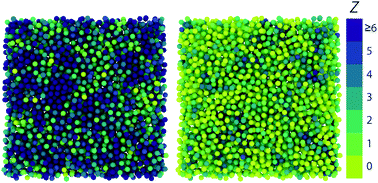Linking slow dynamics and microscopic connectivity in dense suspensions of charged colloids†
Abstract
The quest to unravel the nature of the glass transition, where the viscosity of a liquid increases by many orders of magnitude, while its static structure remains largely unaffected, remains unresolved. While various structural and dynamical precursors to vitrification have been identified, a predictive and quantitative description of how subtle changes at the microscopic scale give rise to the steep growth in macroscopic viscosity is missing. It was recently proposed that the presence of long-lived bonded structures within the liquid may provide the long-sought connection between local structure and global dynamics. Here we directly observe and quantify the connectivity dynamics in liquids of charged colloids en route to vitrification using three-dimensional confocal microscopy. We determine the dynamic structure from the real-space van Hove correlation function and from the particle trajectories, providing upper and lower bounds on connectivity dynamics. Based on these data, we extend Dyre's model for the glass transition to account for particle-level structural dynamics; this results in a microscopic expression for the slowing down of relaxations in the liquid that is in quantitative agreement with our experiments. These results indicate how vitrification may be understood as a dynamical connectivity transition with features that are strongly reminiscent of rigidity percolation scenarios.



 Please wait while we load your content...
Please wait while we load your content...